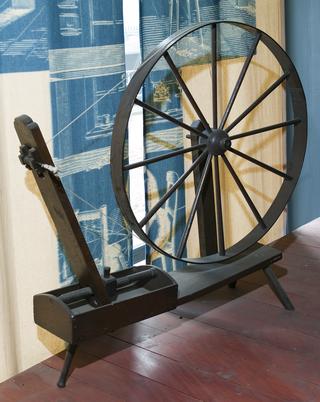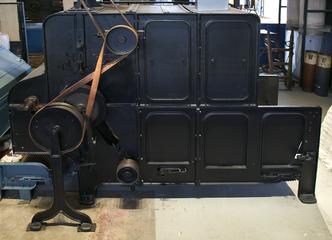
Ribbon loom with jacquard head
- Made:
- circa 1900 in Coventry






Ribbon loom, made by T. F. Wilkinson & Co. Ltd, Coventry, c.1900. Fitted on the top with Jacquard head made by J. McMurdo Ltd, Manchester. Used at Cash's ribbon manufacturers in Coventry.
The jacquard head atop this ribbon loom acts as a programming system, giving instructions to the loom to weave a particular pattern. The loom can weave four ribbons at the same. It was used at Cash's in Coventry, which manufactured ribbons, as well as name tapes, bookmarks and luggage straps. Today, it runs in the Science and Industry Museum's Textiles Gallery.
When it was invented in 1804 by Joseph Marie Jacquard, the Jacquard system transformed the way patterned cloth could be produced, making it much easier and cheaper to manufacture. A jacquard loom could be operated by an unskilled worker and the weaver no longer required an assistant to manually raise and lower the right combination of warp threads needed to create a pattern.
The invention also represented a revolution in human-machine interaction, in its use of interchangeable punch cards to instruct the loom to carry out an automated task. The jacquard loom is often considered a predecessor to the modern computer because it uses a binary system to store information that can be read by the loom and reproduced many times over.
Woven fabric is made by passing threads, the warp and the weft, over and under one another. On a jacquard loom, interchangeable cards with small, punched holes, control which warp threads are raised to allow the weft thread to pass under them.
When a card is pushed towards a set of pins on the jacquard head, where there are punched holes, the pins go through, activating corresponding hooks which raise their warp threads. Where there are no holes, the pins press against the card, stopping the corresponding hooks from raising their threads. The shuttle then travels across the loom, carrying the weft thread under the warp threads which have been raised and over those which have not. A set of these cards, each one with a different combination of punched holes, is read sequentially, reproducing a particular pattern the cloth the loom weaves.
Details
- Category:
- Textile Industry
- Object Number:
- Y1969.42
- Materials:
- wood (unidentified), iron and cotton (fibre)
- Measurements:
-
4267 mm x 1118 mm x 2540 mm,
- credit:
- Gift of Herbert Museum & Art Gallery




